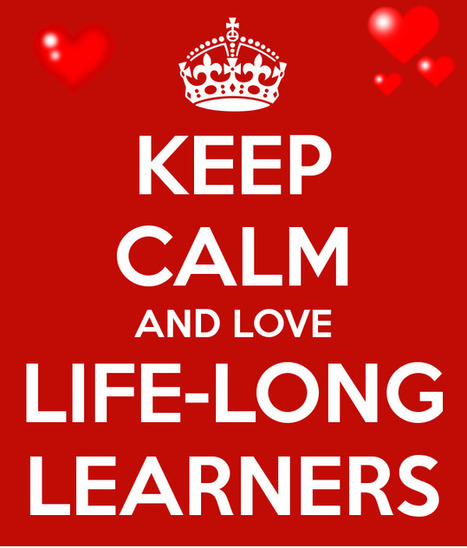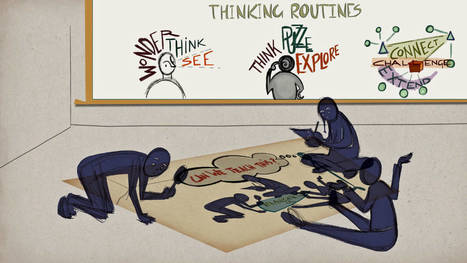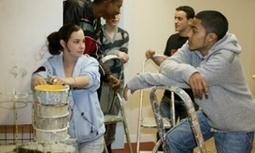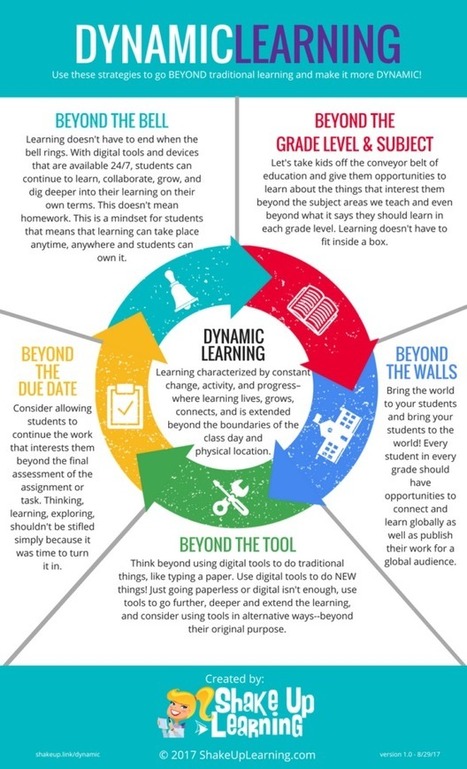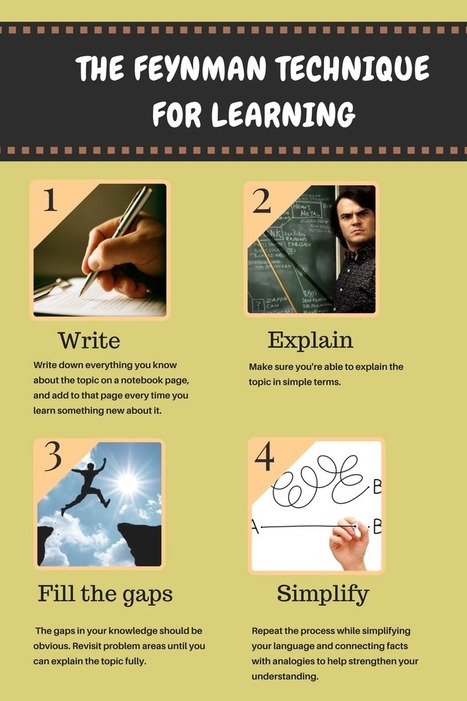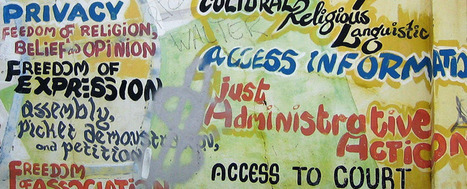Digital and numeracy skills are amongst those that are most sought after by employers, and can help you progress in work and boost your job prospects. Digital skills can be anything from using social media and staying safe online to coding, programming or digital marketing.
Get Started for FREE
Sign up with Facebook Sign up with X
I don't have a Facebook or a X account
 Your new post is loading... Your new post is loading...
 Your new post is loading... Your new post is loading...

Nataliia Viatkina/Наталія Вяткіна's curator insight,
March 26, 2017 4:20 AM
Professional development for teachers themselves, as personalities, adult people, universally, independently from schooling is very interesting idea, humanistic , and useful for school eventually

Prof. Dr. Kai Reinhardt's curator insight,
March 30, 2017 2:42 AM
Hier gibt es eine gute Sammlung an neuen Wissenstransfer-Formaten...
R's curator insight,
April 6, 2017 1:31 PM
Growth and learning beyond schooling - think outside in-service and conferences/professional workshops.

Gust MEES's curator insight,
January 20, 2017 3:26 AM
Lifelong learning is becoming an economic imperative
Technological change demands stronger and more continuous connections between education and employment, says Andrew Palmer. The faint outlines of such a system are now emerging.
Learn more / En savoir plus / Mehr erfahren:
http://www.scoop.it/t/21st-century-learning-and-teaching/?tag=Life-Long-Learning
Lina Kherfan's curator insight,
April 3, 2016 8:19 PM
this article talks about the importance of how children think and learn. the author stresses on the fact that for better learning, students need to have a better structure for learning, hence the title. the author states students often do not have a good structure for thinking. students tend just to memorize things and don't know how to do deep learning. the author states that teachers only teach one part of this structure. which is thinking about thinking. the structre for better thinking is not only thinking about thinking though, there is more to it. the only part of it is to monitoring and directing thinking. " When a student is reading and stops to realize he’s not really understanding the meaning behind the words, that’s monitoring. And most powerfully, directing thinking happens when students can call upon specific thinking strategies to redirect or challenge their own thinking." monitoring is being able to check up on yourself and regulate your own learning and directing is when students can take charge of their learning and direct it to what works for them in their self learning. this article talks about the importance of deeper thinking and learning and then switches to how educators can help with the process. i chose this article because i think that it is an important thing for students in K-12 grades. in my highschool, my graduating year, they had put in place a program called common core, which emphasizes this specific topic in student learning. sadly i was not able to partake in it however i do think that it is important for incoming students learn how to think and learn deeper.
Sara Jaramillo's curator insight,
May 21, 2020 1:27 PM
I agree with what this article says and I consider that education in public schools in Colombia must have into account the theory and the strategies proposed by Ritchhart. It is very important teach students to think by themselves, to take decisions in their learning, to have critical thinking skills, is more useful and meaningful for their learning, that just provide information for them to memorize it. They would not know what to do with this information, and there will be no learning.

Gust MEES's curator insight,
June 14, 2016 3:09 PM
Maker education is currently a major trend in education. But just saying that one is doing Maker Education really doesn't define the teaching practices that an educator is using to facilitate it. Maker education takes on many forms. This post provides an overview of how maker education is being implemented based on the teaching practices…
Learn more / En savoir plus / Mehr erfahren:
http://www.scoop.it/t/21st-century-learning-and-teaching/?tag=pedagogy
http://www.scoop.it/t/21st-century-learning-and-teaching/?tag=Heutagogy
http://www.scoop.it/t/21st-century-learning-and-teaching/?tag=andragogy
https://gustmees.wordpress.com/2015/05/13/andragogy-adult-teaching-how-to-teach-ict/

Gust MEES's curator insight,
December 10, 2013 4:39 PM
A literate educator in the 20th Century is not the same as a literate educator in the 21st Century. Our education system is loaded with many 20th Century holdovers. Most are great people, and good teachers, but they are illiterate in 21st Century terms. We need not cast them aside.
They are valuable and revered sources and educators. We need to support them with methods to upgrade their literacies. It must be a priority.
Learn more:
- http://gustmees.wordpress.com/2013/01/23/is-your-professional-development-up-to-date/
|

Rubiel's curator insight,
September 16, 2017 10:04 PM
The author shares the idea about going beyond the mere fact of being learning only in the classroom. His thoughts on being more autonomous when implementing tools which provide the learners with the opportunity to practice at home leaves a space to consider the way we are making the education happen nowadays. Thereupon, I agree with the consideration about having learners dig deeper into their learning on their own terms with the tecnological devices found in this new era and let them dig deeper on things the are interested in the most. 
David Alzate's curator insight,
September 17, 2017 6:18 PM
This article advices teachers to help their students see learning as an entire life process, and that with all the tools we have available today it does not have to be boring, limited or seen as a burden. Instead, teachers can help them power and further a mindset of proactivity and independence in learning. It means that the children, teenagers or adults in a class can come to understand ,with their teacher’s help, that learning does not always mean to have a board and a teacher in front of a classroom. This article notes that it is of high importance for teachers to constantly be updated in all the new tools that are available for education, and to learn how to use them beyond the common and old way. In this new, connected and more globalized world, learning does not have to stop necessarily when the school day or year ends, it can be at any time, and also interesting and exciting; the deal here is to have teachers and therefore students thinking out of the box, and seeing education notas a burden or a must, but an enjoyable process insofar as this mindset is well provided and spread.

Volkmar Langer's curator insight,
May 2, 2017 4:42 AM
Reminds me on the feynman lectures which made my own physics study even more exciting.

Begoña Pabón's curator insight,
May 2, 2017 4:12 PM
Una tecnica de éxito probado para un mejor y mas eficaz aprendizaje

Andrea Mejia Medina's curator insight,
May 5, 2017 10:39 AM
By attempting to explain a concept in simple terms, you’ll quickly see where you have a good understanding of that concept. You’ll also be able to instantly pinpoint your problem areas, because they’ll be the areas where you either get stuck or where you end up resorting to using complex language and terminology. In addition to helping you pinpoint those problem areas in the concept you’re trying to learn, the Feynman Technique gives you a quick, efficient way to shore up those areas using targeted learning. It’s a simple technique, but it’ll help you study much more efficiently once you put into action. How to Use the Feynman Technique: Step 1: Grab a sheet of paper and write the name of the concept at the top. You can use pretty much any concept or idea – even though the technique is named after Feynman, it’s not limited solely to math and science. Step 2: Explain the concept in your own words as if you were teaching it to someone else. Focus on using plain, simple language. Don’t limit your explanation to a simple definition or a broad overview; challenge yourself to work through an example or two as well to ensure you can put the concept into action. Step 3: Review your explanation and identify the areas where you didn’t know something or where you feel your explanation is shaky. Once you’ve pinpointed them, go back to the source material, your notes, or any examples you can find in order to shore up your understanding. Step 4: If there are any areas in your explanation where you’ve used lots of technical terms or complex language, challenge yourself to re-write these sections in simpler terms. Make sure your explanation could be understood by someone without the knowledge base you believe you already have. Step 5: think like a child; while you’re working through the Feynman Technique for any given concept, it can be useful to pretend that you’re explaining that concept to a child. Doing this will boost your own understanding for one simple reason; a kid is probably going ask why? Why does that formula work? How can you know it`ll always work? While older people often become accustomed to taking things at face value, kids are naturally curious. They’re quick to point out their confusion. This is a great mindset to adopt.

Nataliia Viatkina/Наталія Вяткіна's curator insight,
March 26, 2017 4:20 AM
Professional development for teachers themselves, as personalities, adult people, universally, independently from schooling is very interesting idea, humanistic , and useful for school eventually

Prof. Dr. Kai Reinhardt's curator insight,
March 30, 2017 2:42 AM
Hier gibt es eine gute Sammlung an neuen Wissenstransfer-Formaten...
R's curator insight,
April 6, 2017 1:31 PM
Growth and learning beyond schooling - think outside in-service and conferences/professional workshops.
Nancy Jones's curator insight,
October 7, 2016 8:55 AM
"In our schools, “the emphasis is on what students need to learn, whereas little emphasis—if any—is placed on training students how they should go about learning the content and what skills will promote efficient studying to support robust learning,”

Edumorfosis's curator insight,
December 30, 2016 5:00 PM
En vez de enseñar cosas que ya están accesibles en las redes, las escuelas y universidades deberían practicar la diversidad de formatos de aprendicaje posibles. Ya no es tan importante formar personas intelectuales que sepan de memoria datos declarativos, sino profesionales que tengan capacidades para el aprendizaje autónomo. Hoy día es más importante tener la capacidad de desaprender lo innecesario y reaprender lo que es verdaderamente esencial en el siglo 21.
Kathy Lynch's curator insight,
August 16, 2016 7:51 AM
Thx Gust Mees! 3 Common mistakes we all make in Learning. My students often get caught at #1, Embrace discomfort, because they do not appreciate the key fact that "Effective Learning feels difficult". Cramming (#2) has never worked to help us retain learning; we must space and layer our practice. Finally, connect the learning to our lives and current knowledge.

AMLTaylor66's curator insight,
August 26, 2016 11:41 AM
We may graduate from school, but we never stop learning. New jobs, new roles, new relationships: all require the acquisition of new knowledge. To stop learning is to stop improving.
1. Embrace discomfort 2. Stop cramming 3. Make connections
Learn more / En savoir plus / Mehr erfahren:
http://www.scoop.it/t/21st-century-learning-and-teaching/?tag=Effective+Learning

Viljenka Savli (http://www2.arnes.si/~sopvsavl/)'s curator insight,
December 29, 2015 3:21 AM
It would be nice if every and each teacher added one own thought to the list. I add: ...to pass my enthusiasm to them in a pleasant and inspiring way and to understand and respect their own one... 
Inma Contreras's curator insight,
January 5, 2016 9:16 PM
What teaching means... all,nearly all in a real teacher's life.

Raquel Oliveira's curator insight,
March 19, 2015 5:29 PM
Genial a utilização da taxonomia de Bloom nesse infografico das possiveis atividades em formato "blended"(mix presencial e on line) 
Dr. Melissa A. Bordogna's curator insight,
March 26, 2015 1:59 AM
At a glance, I thought this a helpful infographic. It also made me think of the types of feedback I give my students. In addtion to using a rubric (marking criteria), I tend to provide a fair bit of written feedback. How about you...Which types of feedback have you found to be very effective in terms of student learning (as oppose to time-saving for us)? 
Karen Ellis's curator insight,
April 1, 2015 6:57 PM
Designing and planning assesment in online learning is very important. This infographic reminds us of the importance of making the task student centric and that ongoing feedback is critical.

Gust MEES's curator insight,
May 12, 2013 11:31 AM
Absolutely a MUST read!!!
Learn more:
- http://www.scoop.it/t/21st-century-learning-and-teaching?tag=Education+3.0
|







